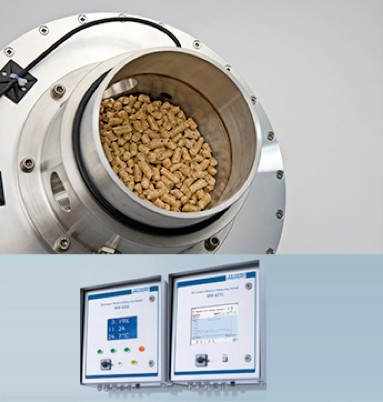• Feed that floats on the surface of the water
• Feed that sinks slowly
• Feed that sinks and is water resistant
• Feed that sinks and is extremely water resistant
Consequently, the density of the fish flakes, granules, pellets or chips is an important aspect for the quality of the product.
The moisture content of the feed is also an important parameter for the quality of the product throughout the production process. Both a high and a low moisture content often lead to loss of quality and can complicate further processing or even prevent it entirely. An ideal moisture content leads to a longer shelf life and prevents the onset of rotting.
Regular checks of the moisture and density are therefore necessary to produce high-quality fish feed. The common method of quality control is through laboratory measurements. Operators in the fish feed process are used to manually taking samples from production and analyzing the moisture and density content in a laboratory. This provides the respective moisture and density values that can, depending on the method, take between 5 minutes and a few hours to obtain. Sample taking is both time-consuming and labor-intensive, and the measured values are generally available too late to be able to control the production process adequately.
TEWS Elektronik has developed a measurement technique with which the moisture content as well as the density of the fish feed can be continuously measured during the production process. With the help of bypass sensors that are integrated into the process, the values are measured and visualized reliably and accurately in a matter of seconds. A quick and targeted intervention in the production process is thus possible. Improved control of the production processes leads to energy savings as well as less wastage and better quality of fish feed. In short, moisture and density measurements during the process increase the efficiency of the entire production chain.
The patented measurement method is based on microwave resonance technology. As soon as the material passes through the field of the microwave sensor, its resonance properties change depending on the water content. A single configuration of the systems is all that’s needed for it to work continuously and reliably. The special unique feature of this technology is the independence of color, density, grain size or surface influences of the product being measured. Contrary to the so-called near-infrared procedure, which measures the moisture content only on the surface, the microwave measurement equipment also determines the core moisture in the inside of the product, for example in pellets or granules.
The Microwave Resonance Method
Water molecules are among the smallest molecules that are positively and negatively charged. The moisture sensor generates a low-energy electro-magnetic field, which interacts with these water molecules inside the product sample. Since the microwave field penetrates a few centimeters into the sample, water is not only detected at the surface but also in the product’s core.
The product sample reduces the propagation speed of the microwave field, and the water molecules in the sample perpetually align to the electromagnetic field, thus depriving it of energy. The moisture meter continuously measures these two effects, which are referred to as the dual parameter method.
A moisture value is then calculated on the basis of the resonance parameters. For every product, the moisture meter is calibrated with the aid of a laboratory method (e.g. LOD method or Karl Fischer Titration), so that the product’s moisture content can be displayed, stored or processed as a percentage value.
The microwave resonance method can also be used to measure bulk density, sample mass or a sample’s weight per area.
TEWS Elektronik has been developing and manufacturing its patented microwave moisture and density measurement systems, which are used for process control and laboratory QA in the feed industry, for over 30 years. Based in Hamburg, Germany, the company is also active in the USA, with its local subsidiary TEWS of America, and has established service points in Hong Kong and Bangkok.
The MW 4260/70 enables the continuous in-line measurement in processing lines.
Up to 3,500 measurements per second are possible.
